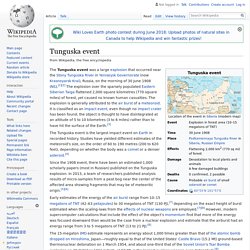

Tunguska event. The Tunguska event was a large explosion that occurred near the Stony Tunguska River in Yeniseysk Governorate (now Krasnoyarsk Krai), Russia, on the morning of 30 June 1908 (NS).[1][2] The explosion over the sparsely populated Eastern Siberian Taiga flattened 2,000 square kilometres (770 square miles) of forest, yet caused no known human casualties.

The explosion is generally attributed to the air burst of a meteoroid. It is classified as an impact event, even though no impact crater has been found; the object is thought to have disintegrated at an altitude of 5 to 10 kilometres (3 to 6 miles) rather than to have hit the surface of the Earth.[3] The Tunguska event is the largest impact event on Earth in recorded history. Studies have yielded different estimates of the meteoroid's size, on the order of 60 to 190 metres (200 to 620 feet), depending on whether the body was a comet or a denser asteroid.[4] Description[edit] Trees knocked over by the Tunguska blast. Testimony of S. Notes. Impact event. Artist's impression of a major impact event. The collision between a planet and an asteroid a few kilometers in diameter may release as much energy as several million nuclear weapons detonating simultaneously.
An impact event is a collision between celestial objects causing measurable effects. Impact events have physical consequences and have been found to regularly occur, though typically relatively small and involving asteroids , comets or meteoroids . When terrestrial planets such as Earth are involved in large impact events, there can be physical and biospheric consequences, though atmospheric entry mitigates most surface impacts. Impact events have played a significant role in the evolution of the Solar System since the beginning and in the origins and evolution of the Earth. Sizes and frequencies [ edit ] A bolide undergoing atmospheric entry Small objects frequently collide with Earth.
(The tables above use a density of 2600 kg/m 3 , velocity of 17 km/s, and an angle of 45 degrees) Meteorite. Hoba meteorite: the largest known intact meteorite.

It was discovered in Namibia A meteorite is a solid piece of debris, from such sources as asteroids or comets, that originates in outer space and survives its impact with the Earth's surface. It is called a meteoroid before its impact. A meteorite's size can range from small to extremely large. When a meteoroid enters the atmosphere, friction, pressure, and chemical interactions with the atmospheric gases cause it to heat up and radiate that energy, thus forming a fireball, also known as a meteor or shooting/falling star.
More generally, a meteorite on the surface of any celestial body is a natural object that has come from outer space. Meteorites have traditionally been divided into three broad categories: stony meteorites are rocks, mainly composed of silicate minerals; iron meteorites that are largely composed of metallic iron-nickel; and, stony-iron meteorites that contain large amounts of both metallic and rocky material. Antimatter. In particle physics , antimatter is material composed of antiparticles , which have the same mass as particles of ordinary matter but have opposite charge and quantum spin .

Antiparticles bind with each other to form antimatter in the same way that normal particles bind to form normal matter. For example, a positron (the antiparticle of the electron , with symbol e + ) and an antiproton (symbol p ) can form an antihydrogen atom. Furthermore, mixing matter and antimatter can lead to the annihilation of both, in the same way that mixing antiparticles and particles does, thus giving rise to high-energy photons ( gamma rays ) or other particle–antiparticle pairs. The end result of antimatter meeting matter is a release of energy proportional to the mass as the mass-energy equivalence equation, E = mc 2 shows. [ 1 ] Antimatter is said to be the most expensive material to produce. History of the concept The modern theory of antimatter began in 1928, with a paper [ 6 ] by Paul Dirac . Notation.